Roman legacy in Cologne
I recently visited the Roman-Germanic Museumꜛ (Römisch-Germanisches Museum) in Cologne, that exhibits archeological finds from the Roman and Germanic era in Cologne and the surrounding area. While strolling through the exhibition, I was fascinated by the acute presence of the artifacts on display and the stories behind them. Of course, I’m aware of Cologne’s Roman heritage, but every visit to the museum – even if it has been reduced to a smaller exhibition space due to renovation work – makes me even more aware of the Roman influence on Cologne’s culture and identity. Here are some of my favorite artifacts that I photographed during my visits. The accompanying texts are mostly based on the information provided by the museum.
 Map of ancient Cologne’s connecting roads to other Roman settlements in the surrounding area. The map is a photo taken of the museum’s exhibition board.
Map of ancient Cologne’s connecting roads to other Roman settlements in the surrounding area. The map is a photo taken of the museum’s exhibition board.
Cologne’s heritage as a Roman city
Cologne’s story begins in the 1st century BC, when the Romans, under Julius Caesar, recognized the strategic importance of the Rhine River and established a military presence in the region. This initial encampment, set up during the Gallic Wars, was primarily for strategic military purposes, but its location soon proved advantageous for trade as well, laying the groundwork for its future growth.
 Extent of the Roman Empire in 50 CE, when Cologne was elevated to a ‘colonia’, officially named Colonia Claudia Ara Agrippinensium (CCAA). The map is a photo taken of the museum’s exhibition board.
Extent of the Roman Empire in 50 CE, when Cologne was elevated to a ‘colonia’, officially named Colonia Claudia Ara Agrippinensium (CCAA). The map is a photo taken of the museum’s exhibition board.
The inception of Roman Cologne as a city, transitioning from its initial role as a military base, was initiated under the rule of Emperor Augustus. Around the time of Christ’s birth, Augustus decreed the establishment of what was then known as the oppidum Ubiorum, located in what is now the historical heart of modern Cologne. This area was strategically chosen for its protection against Rhine floods and its proximity to key regional roads. It became the new home for the Germanic Ubii tribe. Rome’s intent was to establish a central sanctuary for the proposed Germanic province, symbolized by the altar dedicated to Roma and Augustus. From its earliest days, the city was adorned with splendid public buildings, quickly becoming a hub for trade and commerce.


Left: Cologne in early Roman times, 19/18 BC. Right: Colonia Claudia Ara Agrippinensium (CCAA), 50 CE. Both maps are photos of the museum’s exhibition boards.
In the year 50 CE, at the behest of his niece and wife Agrippina, Emperor Claudius elevated Cologne to the status of a colonia, renaming it Colonia Claudia Ara Agrippinensium (CCAA). This significant upgrade granted its inhabitants Roman citizenship, along with all its accompanying benefits. Inspired by the grandeur of Rome, the citizens of CCAA embarked on an ambitious project to construct their city, complete with a forum, thermal baths, and temples, and they managed their affairs independently.
 Augustus (27 BC - 14 CE), early 1st century CE, found: unknown (probably Rome). Right: Livia (58 BC - 29 CE), early 1st century CE, found: unknown (probably Rome). Under Augustus, Germania was conquered and the oppidum Ubiorum - Cologne - was founded. The toga draped over his head identifies the first autocrat of Rome as a sacrificer or priest. His benevolent features refer to his role as father of the fatherland. Livia, wife of Augustus for 53 years, wears a wreath of ears of corn and poppy capsules, which characterizes her as a priestess of Ceres, the goddess of agriculture The energetic and clever Livia had a great influence on Augustus and his politics.
Augustus (27 BC - 14 CE), early 1st century CE, found: unknown (probably Rome). Right: Livia (58 BC - 29 CE), early 1st century CE, found: unknown (probably Rome). Under Augustus, Germania was conquered and the oppidum Ubiorum - Cologne - was founded. The toga draped over his head identifies the first autocrat of Rome as a sacrificer or priest. His benevolent features refer to his role as father of the fatherland. Livia, wife of Augustus for 53 years, wears a wreath of ears of corn and poppy capsules, which characterizes her as a priestess of Ceres, the goddess of agriculture The energetic and clever Livia had a great influence on Augustus and his politics.
Around 85 CE, Emperor Domitian declared the establishment of the province of Lower Germania, appointing CCAA as its capital. During his reign, Cologne was fortified with an impressive stone city wall. The Praetorium became the residence of the provincial governor. Economically, Cologne blossomed into a thriving metropolis on the banks of the Rhine. Beyond its gates, suburbs emerged, housing residential and commercial buildings, while cemeteries lined the main roads leading north, west, and south of the city.
 Animation of Cologne in the 2nd and 3rd centuries. The animation was exhibited in the museum. I think, this YouTube videoꜛ shows the same movie.
Animation of Cologne in the 2nd and 3rd centuries. The animation was exhibited in the museum. I think, this YouTube videoꜛ shows the same movie.
The primary headquarters of the Roman Rhine fleet, known as the Classis Germanica, was strategically positioned in the southern part of Cologne. This location was chosen for its safety from floods and spanned an area of approximately 7 hectares. Nearby, at the base of a steep slope, lay the fleet’s harbor. From the early 1st century until the late 3rd century CE, this base played a crucial role in securing the border and facilitating transportation.
Within the city limits of Cologne itself, there was no significant military presence. However, smaller units of troops were stationed in the city to serve as guards for the governor, a common practice in provincial capitals like Cologne. Additionally, the city became a popular destination for a large number of veterans who settled in Cologne after completing their military service, drawn by the allure and opportunities of this thriving metropolis.


Left: Cologne at the end of the 1st century, also showing the Roman marine base in the south. – Right: Cologne in the 4th and 5th centuries. Both maps are photos of the museum’s exhibition boards. The scale bar in both images is different.
Beginning in the mid-3rd century, a period of turmoil disrupted the previously peaceful provinces along the Rhine. Germanic tribes frequently raided Roman territories, signaling a shift in regional stability. During this time, Postumus, a rival of Emperor Valerian, established the “Gallic Empire”, and from 260 to 274 CE, he made Cologne its capital. This marked a significant chapter in the city’s history, as it became the center of a breakaway empire.
In the 4th century, efforts to stabilize the region were undertaken by Emperor Constantine, who fortified the Rhine border. A notable part of this defensive strategy was the bridgehead fort at Cologne-Deutz, which was linked to the city by a bridge. These measures, however, were ultimately unable to provide lasting security.
By the middle of the 5th century, the Franks began to exert their influence over Cologne. The city, having witnessed centuries of Roman rule, transitioned into a new era under Frankish control. In the early 6th century, the territory encompassing Cologne was fully integrated into the expanding Frankish Empire under the reign of King Clovis. This transition marked the end of Roman dominance in the region and the beginning of a new epoch in the history of Cologne.
The Roman era laid the foundational stone for Cologne’s urban structure and cultural landscape. The grid pattern of the Roman city, with its roads, public buildings, and housing, influenced the medieval and modern cityscape. Roman law, language, and customs had a lasting impact on the local Gallic tribes, leading to a fusion of Roman and Germanic cultures.
Economically, the Romans introduced advanced techniques in agriculture, viticulture, and trade, which significantly boosted the region’s prosperity. The introduction of Roman architectural techniques, including the use of bricks and the construction of monumental buildings, left a lasting architectural legacy.
Examples of the Roman presence in Cologne
People of Cologne
In its heyday, Roman Cologne was a vibrant metropolis on the edge of the empire with around 40,000 inhabitants. The citizens liked to call themselves Agrippinians after the Empress Agrippina. The surviving evidence paints a colorful picture of the city’s society. Freemen, freedmen, slaves, craftsmen, merchants, artists, soldiers, priests and city councillors provide a small insight into their lives with their stone inscriptions - except for the poor, as they left no traces behind.
People from different cultural backgrounds were already living in Cologne in Roman times. Immigration formed an important basis for the existence of the settlement. Soldiers were a large group. The first generation of legionaries came from Italy and southern France. Traditional hometowns include Pavia, Bologna and Fréjus. In the service of Rome were inhabitants of the Alpine countries or even present-day Hungary. Specialists from Egypt, Greece, Turkey and England served in the fleet. Civilians were also drawn to Cologne from abroad. For various reasons, they mainly came from Gaul, Germania and Italy. Most of them found a new home here. People of different origins became locals.
 A citizen of Cologne, late 1st/2nd century CE, Location: Cologne, Bonner Straße. Wealthy citizens of Cologne commissioned their tomb monuments during their lifetime and had them richly decorated, often with their portraits as busts or statues. The head was probably part of a tomb. It is rather crudely crafted and may have been placed at a great height.
A citizen of Cologne, late 1st/2nd century CE, Location: Cologne, Bonner Straße. Wealthy citizens of Cologne commissioned their tomb monuments during their lifetime and had them richly decorated, often with their portraits as busts or statues. The head was probably part of a tomb. It is rather crudely crafted and may have been placed at a great height.
 Gravestone for Burrus from Frejus, 60-70 CE, found: Cologne, Luxemburger Straße. Inscription: “Q(uintus) POMPEI/VS Q(uinti filius) ANIEN/SIS FORO IVLI / BVRRVS MIL(es) EX / LEG(ione) XV ANN(orum) L / STIP (endiorum) XX H(ic) S(itus) E(st) H(eres) F(aciendum) C(uravit)” – “Quintus Pompeius Burrus, son of Quintus, from the civil district of Aniensis, native of Fréjus, soldier of the 15th legion, (deceased at the age of) 50 years after 20 years of service, is buried here. His heir had (the tombstone) placed.” Pompeius Burrus was a Roman citizen from Southern France, probably assigned to the office of the governor in Cologne.
Gravestone for Burrus from Frejus, 60-70 CE, found: Cologne, Luxemburger Straße. Inscription: “Q(uintus) POMPEI/VS Q(uinti filius) ANIEN/SIS FORO IVLI / BVRRVS MIL(es) EX / LEG(ione) XV ANN(orum) L / STIP (endiorum) XX H(ic) S(itus) E(st) H(eres) F(aciendum) C(uravit)” – “Quintus Pompeius Burrus, son of Quintus, from the civil district of Aniensis, native of Fréjus, soldier of the 15th legion, (deceased at the age of) 50 years after 20 years of service, is buried here. His heir had (the tombstone) placed.” Pompeius Burrus was a Roman citizen from Southern France, probably assigned to the office of the governor in Cologne.
 Gravestone for the soldier Manilius Genialis, late 1st century CE, found: Bonn. “Inscription: Dis) M(anibus) / T(ito) MANILIO GENIALI / AGRIPPIN(ensi) STIP(endiorum) XII / T(itus) M(a)NILIVS IVCVNDVS” – “To the gods of the dead. For Titus Manilius Genialis from Cologne, (deceased after) 12 years of service, (set this stone) Titus Manilius lucundus.” Genialis was buried in Bonn and referred to himself as Agrippinenses.
Gravestone for the soldier Manilius Genialis, late 1st century CE, found: Bonn. “Inscription: Dis) M(anibus) / T(ito) MANILIO GENIALI / AGRIPPIN(ensi) STIP(endiorum) XII / T(itus) M(a)NILIVS IVCVNDVS” – “To the gods of the dead. For Titus Manilius Genialis from Cologne, (deceased after) 12 years of service, (set this stone) Titus Manilius lucundus.” Genialis was buried in Bonn and referred to himself as Agrippinenses.
 A Ubian woman, 1st century CE, found: Cologne, Luxemburger Straße. Married ubian women wore large hoods that completely covered their hair. Large decorative pins were inserted at the sides to fasten them.
A Ubian woman, 1st century CE, found: Cologne, Luxemburger Straße. Married ubian women wore large hoods that completely covered their hair. Large decorative pins were inserted at the sides to fasten them.
 Local clothing, 2nd/3rd century CE, found: Cologne, various sites. Men and occasionally women wore hooded cloaks to protect them from wind and weather. Married Ubian women wore a large hood as part of their costume. The women’s garment consisted of a floor-length undergarment and a wide, symmetrically wrapped cloak, which was held at the front with a clasp.
Local clothing, 2nd/3rd century CE, found: Cologne, various sites. Men and occasionally women wore hooded cloaks to protect them from wind and weather. Married Ubian women wore a large hood as part of their costume. The women’s garment consisted of a floor-length undergarment and a wide, symmetrically wrapped cloak, which was held at the front with a clasp.
 Goddess Nehalennia, 2nd century CE, found: Cologne, Hohe Straße. Nehalennia wears the native robe closed at the chest with a clasp and holds a basket with sacrificial cakes. A dog lies next to her. The native goddess was regarded as the patron saint of seafaring. Sailors and merchants sought her protection, especially on the Rhine and the English Channel.
Goddess Nehalennia, 2nd century CE, found: Cologne, Hohe Straße. Nehalennia wears the native robe closed at the chest with a clasp and holds a basket with sacrificial cakes. A dog lies next to her. The native goddess was regarded as the patron saint of seafaring. Sailors and merchants sought her protection, especially on the Rhine and the English Channel.
Importand Roman figures


Left: Agrippina the Elder (14 BC - 33 CE), 1st century CE, found: unknown. Vipsania Agrippina was a granddaughter of Emperor Augustus and married his great-nephew and designated successor Germanicus. As commander-in-chief of the Rhine troops, Germanicus and his family stayed in Cologne in the years 13-16 CE. His wife was instrumental in helping him put down a mutiny of the Rhine legions in 14 A.D. A year later, she gave birth to their daughter Agrippina the Younger in Cologne. Right: Hadrian (117-138 CE), 1st half of 2nd century CE, found: unknown. Emperor Hadrian inspected almost all provinces of the empire and probably also came to Cologne. He refrained from military expansion, instead expanding border fortifications and promoting the founding of cities. He was also enthusiastic about Greek culture and history. Hadrian was the first emperor to grow a beard, presumably in imitation of the Greek philosophers.


Left: Emperor Tiberius (14 - 37 CE), 1st half of 1st century CE, found: unknown. Augustus’ adopted son Tiberius, son of Augustus’ third wife Livia, became Roman emperor. Tiberius, who knew the lands along the Rhine and Danube very well from numerous military campaigns, ordered the Roman military offensives in Germania to cease in 16 CE and Rome withdrew behind the Rhine. Right: Caligula (37-41 CE), 20/30 CE, found: unknown. Caius Caesar Germanicus, son of Germanicus and Vipsania Agrippina, older brother of Julia Agrippina, who later became the mother of the city of Cologne, accompanied his parents to the Rhine and was nicknamed Caligula - “little soldier’s boot” - by the soldiers of the Rhine army. He followed Emperor Tiberius to the throne. A military expedition later took him once again to Gaul and the Rhineland, but without much success. A year later, he was murdered by his bodyguard.
 Emperor Domitian (81 - 96 CE), 1st century CE, found: Cologne, Heumarkt. Domitian established the province of Lower Germania (Germania inferior) and made Cologne its capital. He was probably the initiator and financier of the stone city wall, the mightiest structure in Roman Cologne. Under his rule, a 100-year period of peace began on the Rhine border.
Emperor Domitian (81 - 96 CE), 1st century CE, found: Cologne, Heumarkt. Domitian established the province of Lower Germania (Germania inferior) and made Cologne its capital. He was probably the initiator and financier of the stone city wall, the mightiest structure in Roman Cologne. Under his rule, a 100-year period of peace began on the Rhine border.
Everyday life in Roman Cologne
Here is a selection of objects that illustrate the everyday life of the inhabitants of Roman Cologne.
 1st half of the 1st century CE, found: Cologne, various sites. The Romans brought precious tableware made of silver, glass or ceramics to the Rhine, often as personal possessions. Tableware made of glass or shiny red ceramics (terra sigillata) came from the Mediterranean region at the time and stood out for their intense colors. Terra sigillata potteries soon moved their production from Italy to southern Gaul, closer to the new customers in Germania. Glass kilns from the early days of Roman Cologne have been found on the Eigelstein.
1st half of the 1st century CE, found: Cologne, various sites. The Romans brought precious tableware made of silver, glass or ceramics to the Rhine, often as personal possessions. Tableware made of glass or shiny red ceramics (terra sigillata) came from the Mediterranean region at the time and stood out for their intense colors. Terra sigillata potteries soon moved their production from Italy to southern Gaul, closer to the new customers in Germania. Glass kilns from the early days of Roman Cologne have been found on the Eigelstein.
 Carved ivory comb with griffin from a stone urn, late 1st century CE, found: Cologne, Chlodwigplatz.
Carved ivory comb with griffin from a stone urn, late 1st century CE, found: Cologne, Chlodwigplatz.
 Wafer-thin shells from a stone urn, late 1st century CE, found: Cologne, Chlodwigplatz.
Wafer-thin shells from a stone urn, late 1st century CE, found: Cologne, Chlodwigplatz.
 Compasses, ruler, square, plumb bobs, 1st-3rd century CE, found: Cologne, various sites. With the help of these simple but essential tools and a great deal of experience, the Romans erected the buildings of the settlement.
Compasses, ruler, square, plumb bobs, 1st-3rd century CE, found: Cologne, various sites. With the help of these simple but essential tools and a great deal of experience, the Romans erected the buildings of the settlement.
 Gravestone of a soldier, 1st century CE, found: Cologne, Hohe Straße. Dressed in a tunic and hooded cloak, the foot soldier of a legion wears a sword on his right and a dagger on his left on his elaborately decorated belt. He holds a shield and javelin in his hands. The tombstone was reused in the 4th century to repair the pavement on the north-south axis of the Roman city (cardo maximus). Bottom right: Slingshot balls, early 2nd century CE, findspot: Cologne-Marienburg, Bayenthalgürtel / Slingshot balls, early 2nd century CE, findspot: Cologne-Marienburg, Bayenthalgürtel. The tuff balls were found in large numbers in the naval camp and were probably used as long-range weapons. Tuff powder also found indicates that the balls were made on site. The stones probably came from a demolished building, as indicated by the mortar residue on some of the stone bullets.
Gravestone of a soldier, 1st century CE, found: Cologne, Hohe Straße. Dressed in a tunic and hooded cloak, the foot soldier of a legion wears a sword on his right and a dagger on his left on his elaborately decorated belt. He holds a shield and javelin in his hands. The tombstone was reused in the 4th century to repair the pavement on the north-south axis of the Roman city (cardo maximus). Bottom right: Slingshot balls, early 2nd century CE, findspot: Cologne-Marienburg, Bayenthalgürtel / Slingshot balls, early 2nd century CE, findspot: Cologne-Marienburg, Bayenthalgürtel. The tuff balls were found in large numbers in the naval camp and were probably used as long-range weapons. Tuff powder also found indicates that the balls were made on site. The stones probably came from a demolished building, as indicated by the mortar residue on some of the stone bullets.

 Lost in the Rhine harbor. 1st/2nd century CE, found: Cologne, Kurt-Hackenberg-Platz. Casseroles were all-purpose vessels. You could eat or drink from them, use them to prepare food or for scooping water and mixing wine. The sieve was part of the drinking utensils and was used to separate spices from wine, for example. It is impossible to imagine everyday life without these vessels. They were probably lost unintentionally.
Lost in the Rhine harbor. 1st/2nd century CE, found: Cologne, Kurt-Hackenberg-Platz. Casseroles were all-purpose vessels. You could eat or drink from them, use them to prepare food or for scooping water and mixing wine. The sieve was part of the drinking utensils and was used to separate spices from wine, for example. It is impossible to imagine everyday life without these vessels. They were probably lost unintentionally.
 People’s close relationship with water: a bronze decoration, 2nd and 3rd century CE, found: Cologne, Luxemburger Straße and unknown find location. The bronze decoration shows the face of the divine ocean. A ship adorns the amber, artistically designed in the shape of a shell, with three divine beings playing music on board. An idyllic scene of fishing against the backdrop of a harbor town delighted onlookers at the oil lamp.
People’s close relationship with water: a bronze decoration, 2nd and 3rd century CE, found: Cologne, Luxemburger Straße and unknown find location. The bronze decoration shows the face of the divine ocean. A ship adorns the amber, artistically designed in the shape of a shell, with three divine beings playing music on board. An idyllic scene of fishing against the backdrop of a harbor town delighted onlookers at the oil lamp.
 Ship, amber, 2nd and 3rd century CE, found: Cologne, Luxemburger Straße and unknown find location. The ship is artistically designed in the shape of a shell, with three divine beings playing music on board
Ship, amber, 2nd and 3rd century CE, found: Cologne, Luxemburger Straße and unknown find location. The ship is artistically designed in the shape of a shell, with three divine beings playing music on board
 Oil lamp, 2nd and 3rd century CE, found: Cologne, Luxemburger Straße and unknown find location. Idyllic scene of fishing against the backdrop of a harbor town.
Oil lamp, 2nd and 3rd century CE, found: Cologne, Luxemburger Straße and unknown find location. Idyllic scene of fishing against the backdrop of a harbor town.
 Relief with ship’s stern, late 1st century CE, found: Cologne, banks of the Rhine (near Heumarkt). The block belonged to a large funerary monument. The helmsman stands at the helm in the stern of a rowing boat. The rowers sit facing him, some recognizable as locals due to their pants. It is unclear whether a military or civilian ship is depicted here.
Relief with ship’s stern, late 1st century CE, found: Cologne, banks of the Rhine (near Heumarkt). The block belonged to a large funerary monument. The helmsman stands at the helm in the stern of a rowing boat. The rowers sit facing him, some recognizable as locals due to their pants. It is unclear whether a military or civilian ship is depicted here.
 Gravestone of the perfume merchant Harparonius, 2nd century CE, found: Cologne, Am Kunibertskloster. Inscription: “SEX(to) HAPARO/NIO IVSTINO / NEGOTATO/RI SEPLASIA/ RIO FRATRES / FAC(iendum) CVR(averunt)” – “His brothers had the tomb built for Sextus Harparonius lustinus, a perfume merchant.” Seplasiaria refers to the Seplasia, a street, in Campania’s Capua with numerous perfumeries. Seplasia was transferred to fragrances of all kinds.
Gravestone of the perfume merchant Harparonius, 2nd century CE, found: Cologne, Am Kunibertskloster. Inscription: “SEX(to) HAPARO/NIO IVSTINO / NEGOTATO/RI SEPLASIA/ RIO FRATRES / FAC(iendum) CVR(averunt)” – “His brothers had the tomb built for Sextus Harparonius lustinus, a perfume merchant.” Seplasiaria refers to the Seplasia, a street, in Campania’s Capua with numerous perfumeries. Seplasia was transferred to fragrances of all kinds.
 A doctor’s grave, 2nd century CE, found: Cologne-Marienburg. Among the grave goods, three surgical instruments in a bronze case identify the deceased as a doctor: a scalpel, tweezers with toothed jaws and a spatula probe. The cutlery is complemented by a medicine box, a slate pallet for rubbing and bronze bowls for mixing medicines. The set of three iron tools is unique in a doctor’s grave: the doctor probably used scissors, pliers and a lever to pull teeth.
A doctor’s grave, 2nd century CE, found: Cologne-Marienburg. Among the grave goods, three surgical instruments in a bronze case identify the deceased as a doctor: a scalpel, tweezers with toothed jaws and a spatula probe. The cutlery is complemented by a medicine box, a slate pallet for rubbing and bronze bowls for mixing medicines. The set of three iron tools is unique in a doctor’s grave: the doctor probably used scissors, pliers and a lever to pull teeth.

 Glass production in Cologne, 2nd-4th century CE, found: Cologne, various sites. The manufacture of glass products in Cologne is known from furnaces, slags and glass ports. The frequency of similar types of glass also suggests that they were produced locally. Simple shapes such as barrel jugs and square bottles were produced, as well as more elaborate items such as jars with overlays such as nubs or glass threads.
Glass production in Cologne, 2nd-4th century CE, found: Cologne, various sites. The manufacture of glass products in Cologne is known from furnaces, slags and glass ports. The frequency of similar types of glass also suggests that they were produced locally. Simple shapes such as barrel jugs and square bottles were produced, as well as more elaborate items such as jars with overlays such as nubs or glass threads.

 Altar for the goddess Virtus, 3rd century CE, found in Cologne-Bocklemünd. Inscription: “DEAE VIRTVTI / FATALIS NEG(otiator) A(uli) LAETI / GRATI LIB (ertus) V(otum) Solvit) Libens) M(erito)” – “For the goddess Virtus. The merchant Fatalis, freedman of Aulus Laetus Gratus, gratefully and gladly fulfilled his vow.” The goddess, embodiment of soldierly bravery, is armed with lance, helmet and sword.
Altar for the goddess Virtus, 3rd century CE, found in Cologne-Bocklemünd. Inscription: “DEAE VIRTVTI / FATALIS NEG(otiator) A(uli) LAETI / GRATI LIB (ertus) V(otum) Solvit) Libens) M(erito)” – “For the goddess Virtus. The merchant Fatalis, freedman of Aulus Laetus Gratus, gratefully and gladly fulfilled his vow.” The goddess, embodiment of soldierly bravery, is armed with lance, helmet and sword.
 Hygieia salus, 2nd half of the 2nd century CE, found in Cologne-Marienburg. Daughter and companion of the Greek god of healing, Asclepius, Hygieia is the personification of health. In Rome and the provinces, she corresponds to Salus, the goddess of the public welfare of the emperor and the state. The goddess is feeding a snake with eggs from the bowl in her left hand. The statue was probably a votive gift. It was found in the storage area of the Roman Rhine fleet.
Hygieia salus, 2nd half of the 2nd century CE, found in Cologne-Marienburg. Daughter and companion of the Greek god of healing, Asclepius, Hygieia is the personification of health. In Rome and the provinces, she corresponds to Salus, the goddess of the public welfare of the emperor and the state. The goddess is feeding a snake with eggs from the bowl in her left hand. The statue was probably a votive gift. It was found in the storage area of the Roman Rhine fleet.
 Besides its glass production, there was also relevant ceramic production in Cologne, 2nd century CE, found in Cologne, various sites.
Besides its glass production, there was also relevant ceramic production in Cologne, 2nd century CE, found in Cologne, various sites.
 Prehistoric ceramic production in Cologne, 5500-4950 BC, found in Cologne-Lindenthal.
Prehistoric ceramic production in Cologne, 5500-4950 BC, found in Cologne-Lindenthal.
 Meleager, 1st/2nd century CE, found: Cologne, Domhof. The Greek hero Meleager killed the giant boar with which the goddess Artemis vengefully ravaged the land of Calydon. The marble figure, modeled on a famous Greek sculpture, once decorated a room or the garden of a luxurious house in Roman Cologne and referred to the Greek education of its inhabitants.
Meleager, 1st/2nd century CE, found: Cologne, Domhof. The Greek hero Meleager killed the giant boar with which the goddess Artemis vengefully ravaged the land of Calydon. The marble figure, modeled on a famous Greek sculpture, once decorated a room or the garden of a luxurious house in Roman Cologne and referred to the Greek education of its inhabitants.
 Hercules, 3rd century CE, found: Cologne, Severinswall. The Nemean lion, a creature of formidable strength in Greek mythology, was known for its impervious hide, against which no weapon could prevail. Hercules, in a display of extraordinary might, overcame this beast not through conventional means but by strangling it with his bare hands. Following this feat, Hercules donned the lion’s fur as armor, which granted him invulnerability. This impenetrable fur, along with his club, became his iconic symbols. The tale of Hercules defeating the Nemean lion, a representation of the triumph of humanity over evil, was often depicted in art and sculpture, likely serving as a powerful symbol atop a tomb, signifying protection and valor.
Hercules, 3rd century CE, found: Cologne, Severinswall. The Nemean lion, a creature of formidable strength in Greek mythology, was known for its impervious hide, against which no weapon could prevail. Hercules, in a display of extraordinary might, overcame this beast not through conventional means but by strangling it with his bare hands. Following this feat, Hercules donned the lion’s fur as armor, which granted him invulnerability. This impenetrable fur, along with his club, became his iconic symbols. The tale of Hercules defeating the Nemean lion, a representation of the triumph of humanity over evil, was often depicted in art and sculpture, likely serving as a powerful symbol atop a tomb, signifying protection and valor.
 Vase of the gods, late 2nd/early 3rd century CE, found: Troisdorf, Fliegenberg. The ceramic pot imitates a riveted metal vessel and is decorated with the heads of Celtic deities. Made in a Roman pottery in northern Gaul, it was found in a Germanic princely tomb.
Vase of the gods, late 2nd/early 3rd century CE, found: Troisdorf, Fliegenberg. The ceramic pot imitates a riveted metal vessel and is decorated with the heads of Celtic deities. Made in a Roman pottery in northern Gaul, it was found in a Germanic princely tomb.
 Silver spoon, 1st-3rd century CE, found in Cologne.
Silver spoon, 1st-3rd century CE, found in Cologne.
 Dinnerware, 1st-3rd century CE, found in Cologne.
Dinnerware, 1st-3rd century CE, found in Cologne.
 Dinnerware, 1st-3rd century CE, found in Cologne.
Dinnerware, 1st-3rd century CE, found in Cologne.
 Dinnerware, 1st-3rd century CE, found in Cologne.
Dinnerware, 1st-3rd century CE, found in Cologne.
 Dinnerware, 1st-3rd century CE, found in Cologne.
Dinnerware, 1st-3rd century CE, found in Cologne.
 Dinnerware, 1st-3rd century CE, found in Cologne.
Dinnerware, 1st-3rd century CE, found in Cologne.
 Candlestick, 1st-3rd century CE, found in Cologne.
Candlestick, 1st-3rd century CE, found in Cologne.
 Oil lamp, 1st-3rd century CE, found in Cologne.
Oil lamp, 1st-3rd century CE, found in Cologne.
 Drinking vessels, 1st-3rd century CE, found in Cologne.
Drinking vessels, 1st-3rd century CE, found in Cologne.
 Dinnerware, 1st-3rd century CE, found in Cologne.
Dinnerware, 1st-3rd century CE, found in Cologne.
 Small head of en emperor, 1st-3rd century, found: unknown. Small imperial images, as a sign of power, were often given as gifts to deserving people.
Small head of en emperor, 1st-3rd century, found: unknown. Small imperial images, as a sign of power, were often given as gifts to deserving people.
 Toy Gladiator. From a collection from the 1st-3rd century CE, found: Cologne.
Toy Gladiator. From a collection from the 1st-3rd century CE, found: Cologne.
 Coin with gladiatorial combat as motif. From a collection from the 1st-3rd century CE, found: Cologne.
Coin with gladiatorial combat as motif. From a collection from the 1st-3rd century CE, found: Cologne.
 Theater mask. From a collection from the 1st-3rd century CE, found: Cologne. Actors in the theater wore masks typical of their roles, which also amplified their voices. Theater masks were also hung up in private homes as decoration.
Theater mask. From a collection from the 1st-3rd century CE, found: Cologne. Actors in the theater wore masks typical of their roles, which also amplified their voices. Theater masks were also hung up in private homes as decoration.
 Games, 1st-4th century CE, found in Cologne, various sites. Free time was spent in convivial gatherings with games, music and wine. Game boards were often carved into bricks and gambling with dice or knucklebones was so popular that it had to be repeatedly restricted by law.
Games, 1st-4th century CE, found in Cologne, various sites. Free time was spent in convivial gatherings with games, music and wine. Game boards were often carved into bricks and gambling with dice or knucklebones was so popular that it had to be repeatedly restricted by law.
 Roman cubes, 1st-4th century CE, found in Cologne, various sites.
Roman cubes, 1st-4th century CE, found in Cologne, various sites.
 Games, 1st-4th century CE, found in Cologne, various sites.
Games, 1st-4th century CE, found in Cologne, various sites.
 Reading and writing, 1st-3rd century CE, found in Cologne, various sites. Writing was done with a stylus on wax tablets. The broad end was used to erase mistakes. Ink, quills and expensive papyrus were used less frequently. Children learned arithmetic, reading and writing in private schools that charged fees. Those who could afford it employed a private tutor at home. There was no compulsory education. The amount of simple written material - shopping lists, invitations and the like - suggests that quite a lot of people could read.
Reading and writing, 1st-3rd century CE, found in Cologne, various sites. Writing was done with a stylus on wax tablets. The broad end was used to erase mistakes. Ink, quills and expensive papyrus were used less frequently. Children learned arithmetic, reading and writing in private schools that charged fees. Those who could afford it employed a private tutor at home. There was no compulsory education. The amount of simple written material - shopping lists, invitations and the like - suggests that quite a lot of people could read.
 Reading and writing, 1st-3rd century CE, found in Cologne, various sites.
Reading and writing, 1st-3rd century CE, found in Cologne, various sites.
 Reading and writing, 1st-3rd century CE, found in Cologne, various sites.
Reading and writing, 1st-3rd century CE, found in Cologne, various sites.
 Decorative clothing, 1st-3rd century CE, found in Cologne, various sites. For clothing, yarn was spun and woven by hand. Spindles and weaving aids were used. Coats were held together by robe needles (fibulae). Women adorned themselves with need-les for hair and bonnets. Only wealthy women and men could afford shoes made of fine, open-work leather.
Decorative clothing, 1st-3rd century CE, found in Cologne, various sites. For clothing, yarn was spun and woven by hand. Spindles and weaving aids were used. Coats were held together by robe needles (fibulae). Women adorned themselves with need-les for hair and bonnets. Only wealthy women and men could afford shoes made of fine, open-work leather.
 Various needles, 1st-3rd century CE, found in Cologne, various sites.
Various needles, 1st-3rd century CE, found in Cologne, various sites.
 Frog brooche, 1st-3rd century CE, found in Cologne, various sites.
Frog brooche, 1st-3rd century CE, found in Cologne, various sites.
 Daily hygiene, 1st-4th century CE, found in Cologne, various sites. The Romans went to the public thermal baths every day if possible to exercise, bathe, have massages or medical treatments or to meet friends. They took their personal oil bottles and scrapers with them to clean oil and dirt. The large municipal baths were located on the other side of today’s Cäcilienstraße, in the area around St. Cäcilien Church (now the Schnütgen Museum).
Daily hygiene, 1st-4th century CE, found in Cologne, various sites. The Romans went to the public thermal baths every day if possible to exercise, bathe, have massages or medical treatments or to meet friends. They took their personal oil bottles and scrapers with them to clean oil and dirt. The large municipal baths were located on the other side of today’s Cäcilienstraße, in the area around St. Cäcilien Church (now the Schnütgen Museum).
 Burial inventory of a Frankish woman, 2nd half of the 6th century CE, found: Cologne, St. Severin.
Burial inventory of a Frankish woman, 2nd half of the 6th century CE, found: Cologne, St. Severin.
 Roman jewelry, 1st-4th century CE, found in Cologne, various sites. The material, not the form, determined the jewelry design of the Roman imperial period. Goldsmiths often combined the color of gold and silver with the shimmer of white pearls and the brilliance of green, blue and red gemstones. Emeralds and sapphires, rubies and garnets were particularly popular. Those who could not afford them resorted to glass in these colors. Naturalistic shapes such as snakes as bracelets or crescent moons and Hercules clubs as pendants were decorative and protective amulets. Finger rings with engraved precious or glass stones were used as signet rings.
Roman jewelry, 1st-4th century CE, found in Cologne, various sites. The material, not the form, determined the jewelry design of the Roman imperial period. Goldsmiths often combined the color of gold and silver with the shimmer of white pearls and the brilliance of green, blue and red gemstones. Emeralds and sapphires, rubies and garnets were particularly popular. Those who could not afford them resorted to glass in these colors. Naturalistic shapes such as snakes as bracelets or crescent moons and Hercules clubs as pendants were decorative and protective amulets. Finger rings with engraved precious or glass stones were used as signet rings.


 Roman rings, 1st-4th century CE, found in Cologne, various sites.
Roman rings, 1st-4th century CE, found in Cologne, various sites.
 Jewelry made of amber, chalcedony and gagat, 2-3rd century CE, found in Cologne, various sites. Black gagat imported to the Rhineland from the British Isles, like amber from the Baltic, was probably worked into ornate jewelry, utensils and knick-knacks in specialized workshops in Cologne. In the 3rd century CE, the popular gagat was sometimes combined with gold to create very effective pieces of jewelry. Amber was so valuable that large pieces of the fossilized resin were worth the value of a slave. The bluish moonstone (chalcedony) was particularly prized in late antiquity and the early Middle Ages. What all stones have in common is that they were considered to have healing and protective properties.
Jewelry made of amber, chalcedony and gagat, 2-3rd century CE, found in Cologne, various sites. Black gagat imported to the Rhineland from the British Isles, like amber from the Baltic, was probably worked into ornate jewelry, utensils and knick-knacks in specialized workshops in Cologne. In the 3rd century CE, the popular gagat was sometimes combined with gold to create very effective pieces of jewelry. Amber was so valuable that large pieces of the fossilized resin were worth the value of a slave. The bluish moonstone (chalcedony) was particularly prized in late antiquity and the early Middle Ages. What all stones have in common is that they were considered to have healing and protective properties.
 Jewelry made of amber, chalcedony and gagat, 2-3rd century CE, found in Cologne.
Jewelry made of amber, chalcedony and gagat, 2-3rd century CE, found in Cologne.
 Jewelry made of amber, chalcedony and gagat, 2-3rd century CE, found in Cologne.
Jewelry made of amber, chalcedony and gagat, 2-3rd century CE, found in Cologne.
Other remnants of Roman presence
Cologne still houses numerous Roman structures and ruins. Among them:
- The Roman Tower (Römerturm)
- A part of the ancient city wall, showcasing Roman defensive architecture.
- The Norther Gate
- A stone arch stands prominently on the cathedral slab at the edge of the west portal. The gate was a side entrance to the so-called north gate of the Romans. The reconstruction of the large arch of the gate can be seen in the Roman Germanic Museum and has the inscription CCAA.
- Ubiermonument
- The Ubiermonument, located at “An der Malzmühle / Mühlenbach”, formed the south-eastern corner of Cologne’s city fortifications in Roman times and was discovered by chance during construction work in 1965. The monument was there before the Roman city fortifications that were built next to the tower. It is the oldest Roman stone building in Cologne and also one of the oldest ashlar structures north of the Alps. It can be visited as part of a guided tour.
- Harbor road and sewer
- Right next to the Roman-Germanic Museum, an old harbor road from Roman Cologne made of basalt paving has been preserved. It was discovered in 1969 and carved out again just a few meters from its original location. It is the only street preserved in this form in the middle of a major German city. Right next to it is an old sewage collector that originally stood at Kurt-Hackenberg-Platz, where it flowed into an old arm of the Rhine.
- Sewer under the old town
- Under the Große Budengasse in the middle of Cologne’s old town, a Roman sewer that flowed under the city fortifications to the Rhine has been preserved to this day. A length of 150 meters of the canal is still accessible today. A section of the canal is raised and exhibited on Theo-Burauen-Platz. During the Second World War, the people of Cologne sought shelter from the bombs here, among other things. The underground part of the canal cannot currently be visited.
- The Roman-Germanic Museum
- The museum itself is built on the foundations of a Roman villa. The Dionysus mosaic, which is exhibited in the museum, was also found here.
Conclusion
In conclusion, the Roman heritage of Cologne is not just a chapter in history books but a living part of the city’s heart and identity. From the architectural layout to the artifacts preserved in the Roman-Germanic Museum, the Roman influence is present in many aspects of the city. Its Roman legacy is a testament to Cologne’s ability to integrate and preserve its historical identity through the ages.
Despite being temporarily relocated to the Belgisches Haus at Neumarkt due to extensive renovations at its main building near the Cologne Cathedral, the Roman-Germanic Museum is doing an outstanding job. The challenge of operating in a smaller space has not diminished the quality of the exhibition. In fact, the museum’s curatorial team has skillfully organized the display, ensuring that each artifact and exhibit tells a compelling story of Cologne’s Roman and Germanic past.
The way the exhibition is laid out in the temporary space is commendable. It guides visitors through a chronological journey, starting from the early Roman military encampment to the flourishing city of Colonia Claudia Ara Agrippinensium. The thoughtful arrangement and informative descriptions provide a comprehensive and engaging experience, making the most of the limited space.
However, I’m also looking forward to the reopening of the main building. Unfortunately, the renovation work has been delayed and I don’t know when the museum will reopen. As soon as I know more, I will let you know here.
 The entrance hall of the Roman-Germanic Museum, currently located in the Belgisches Haus at Neumarkt, Cologne.
The entrance hall of the Roman-Germanic Museum, currently located in the Belgisches Haus at Neumarkt, Cologne.
 The main staircase of the Belgisches Haus.
The main staircase of the Belgisches Haus.
 Giant head, exhbitied in the hallways of the Belgisches Haus (unfortunately, there was no furhter description).
Giant head, exhbitied in the hallways of the Belgisches Haus (unfortunately, there was no furhter description).
 Current construction site of the Roman-Germanic Museum. Shown is a replica of the tomb of the legionary veteran Poblicius (on a building site covering), which stood on the Roman highway between Cologne and Bonn, at today’s Chlodwigplatz.
Current construction site of the Roman-Germanic Museum. Shown is a replica of the tomb of the legionary veteran Poblicius (on a building site covering), which stood on the Roman highway between Cologne and Bonn, at today’s Chlodwigplatz.
 A replica of the Dionysus mosaic on a building site covering at the current construction site of the Roman-Germanic Museum.
A replica of the Dionysus mosaic on a building site covering at the current construction site of the Roman-Germanic Museum.
References and further reading
- Website of the Roman-Germanic Museum in Cologneꜛ
- Marcus Trier, Friederike Naumann-Steckner, 14 CE - Römische Herrschaft am Rhein, 2014, Wienand, ISBN: 9783868322262
- Hugo Borger, Helga Schmidt-Glassner, Das Römisch-Germanische Museum Köln, 1977, Callwey, ISBN: 9783766703842
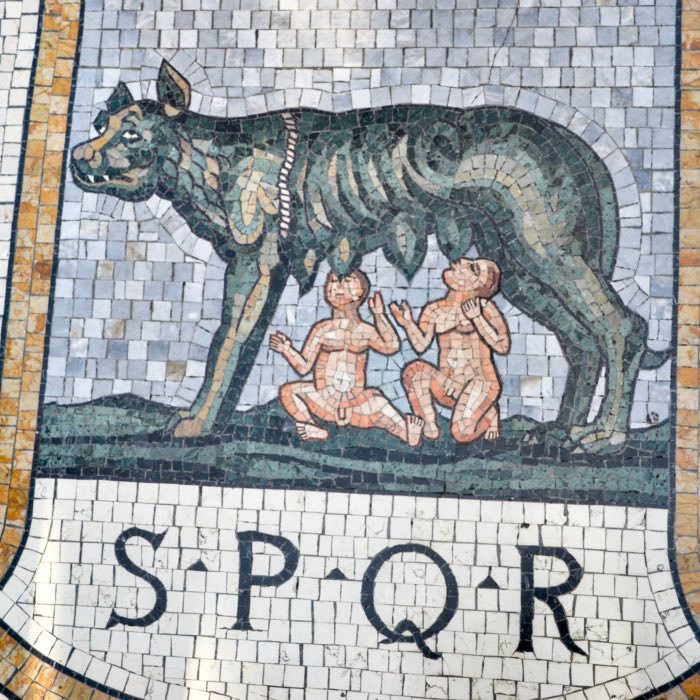
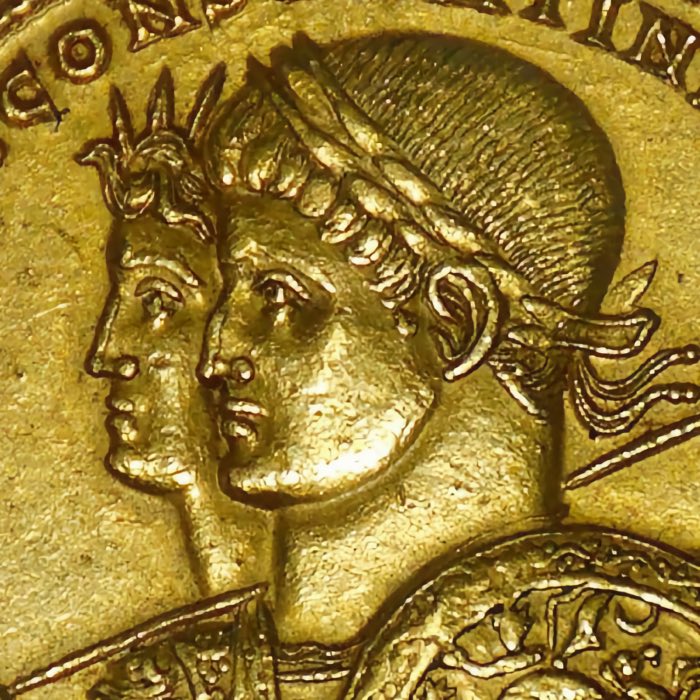
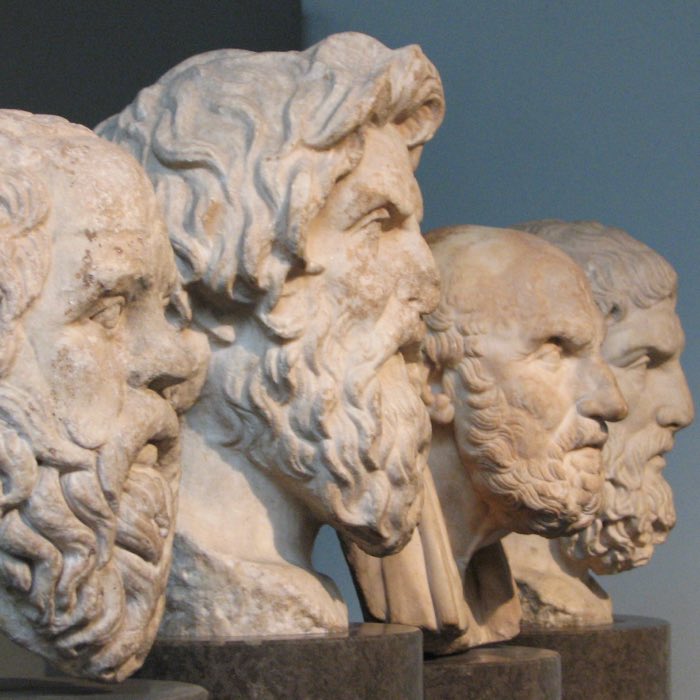
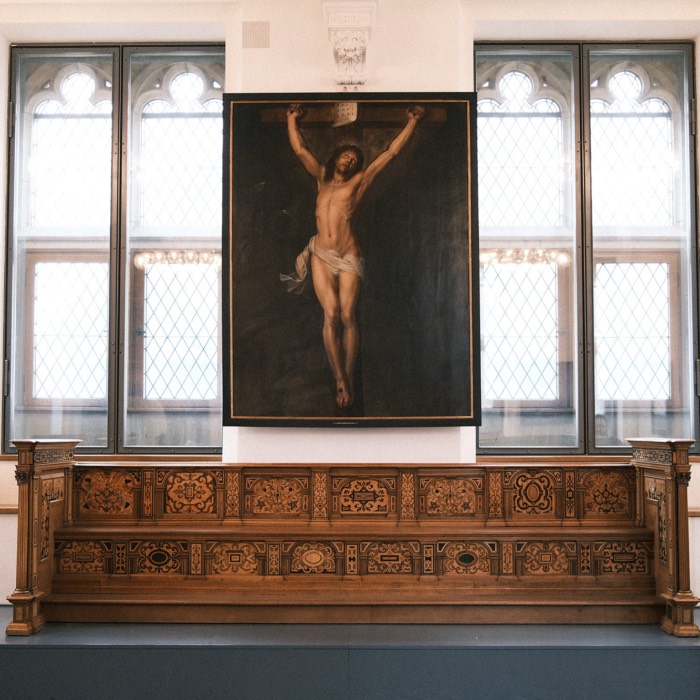
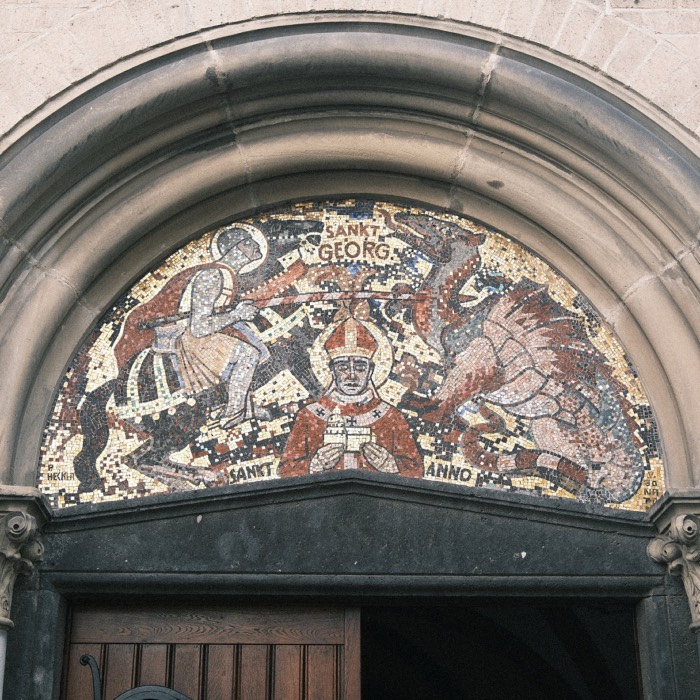
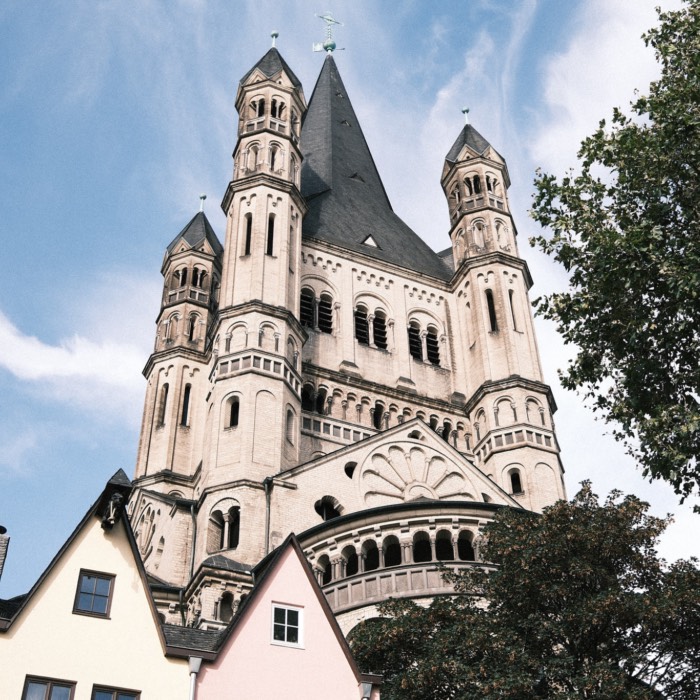

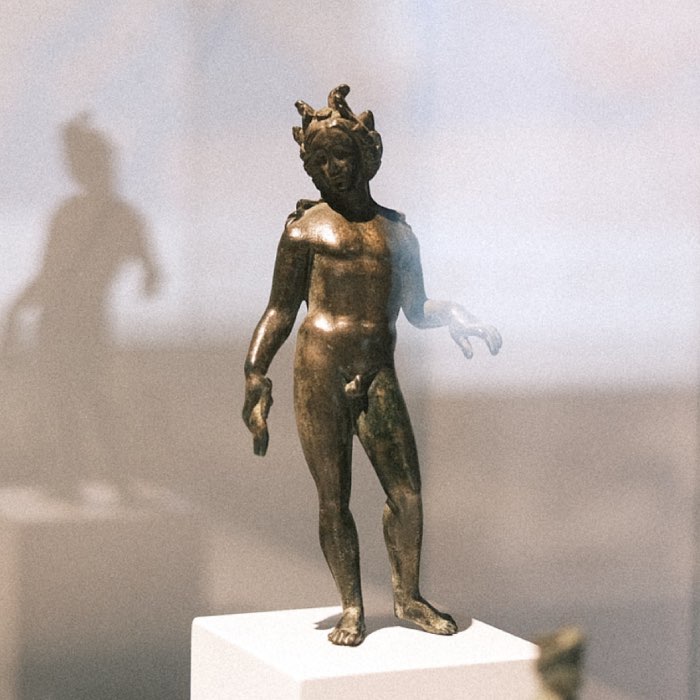
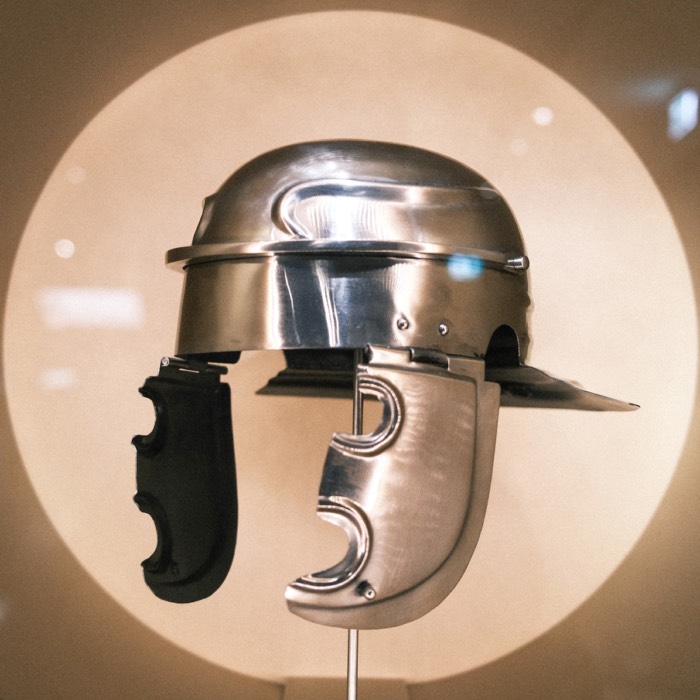
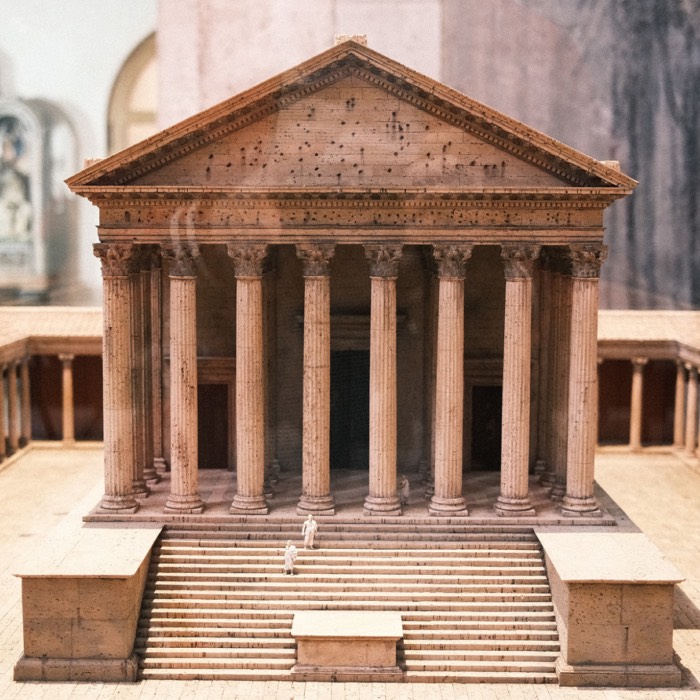
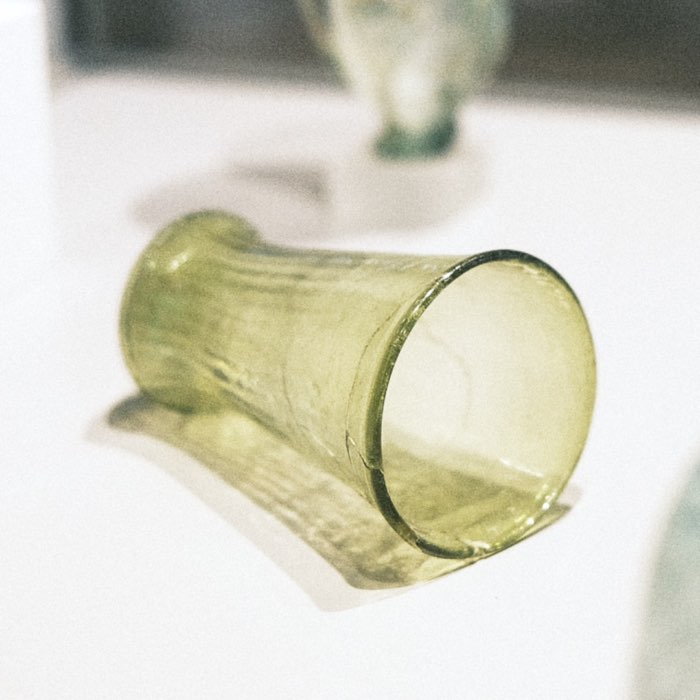







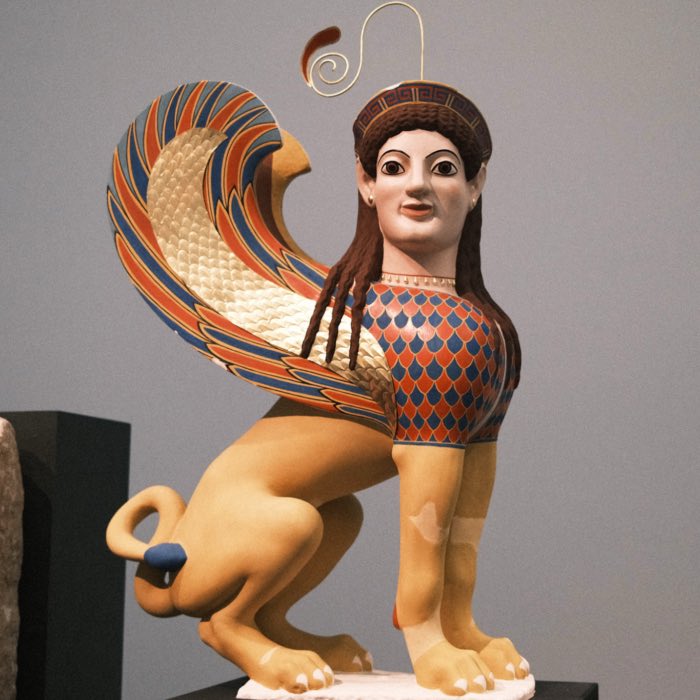
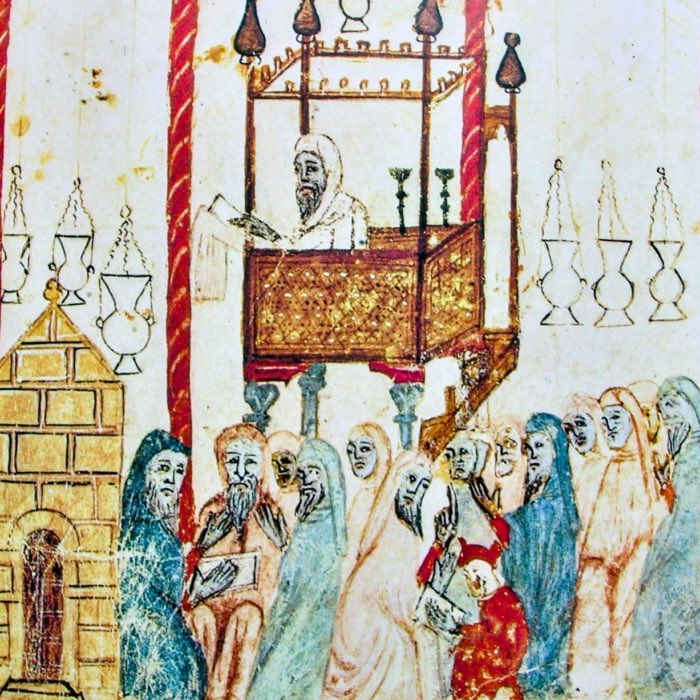
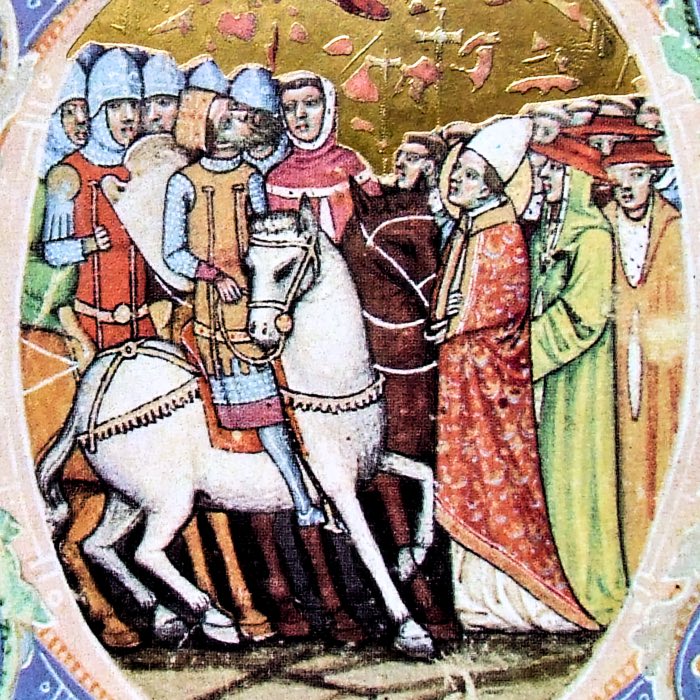
comments